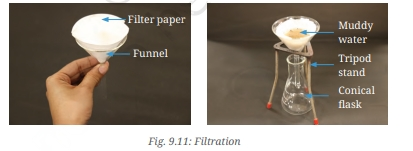Methods of Separation – Complete Guide For Class 6 Science Chapter 9
Welcome to iPrep, your Learning Super App. Our learning resources for the chapter, Methods of Separation in Everyday Life in Science for Class 6th are designed to ensure that you grasp this concept with clarity and perfection. Whether you’re studying for an upcoming exam or strengthening your concepts, our engaging animated videos, practice questions and notes offer you the best of integrated learning with interesting explanations and examples.
Introduction to Methods of Separation
In our everyday life, we often encounter mixtures that need to be separated into their components. This chapter on methods of separation from class 6 science takes us through a fascinating journey exploring different methods of separation used in homes, fields, and industries across India. Each method has its unique application, from handpicking stones from grains to using magnets to separate iron nails from sawdust.
Handpicking: The Simplest Method
This section will discusses one of the simplest methods of separation called hand picking. Let’s understand this part of methods of separation with an example.
Malli and Valli’s summer vacation begins with a visit to their Nani’s house in Haryana. They observe their relatives separating small stones and husks from grains using their hands. This method is called handpicking and is based on differences in size, color, and shape.
Activity: Handpicking in Action
- Steps:
- Take a handful of roasted peanuts.
- Rub them between your palms to remove the skin.
- Blow air to separate the lighter skins from the heavier peanuts.
Handpicking is effective when the components of a mixture are present in small quantities and can be easily distinguished.
Threshing: Separating Grains from Stalks
Now lets continue the example of malli and valli to understand another part of methods of separation called Threshing.
Next, Malli and Valli observe farmers threshing wheat in the fields. Threshing is the process of beating stalks to separate grains. Traditionally, farmers use wooden logs or animals to perform this task, but today, threshing machines are widely used.
Winnowing: Separating Husk from Grains
After threshing, the grains are still mixed with husk. Valli wonders how farmers separate such large quantities of husk. This is done using one of th most commonly used methods of separation called winnowing, where the mixture of grains and husk is thrown into the air. The lighter husk is blown away by the wind, leaving the heavier grains behind.
Activity: Let’s Try Winnowing
- Materials: A bamboo tray with roasted peanuts and peanut skins.
- Steps:
- Hold the tray at an angle and allow the wind to blow away the peanut skins, leaving the peanuts behind.
Winnowing is an effective way of separating lighter and heavier components in mixtures.

Sieving: Separating Particles by Size
Another example of methods of separation uncovers When Malli and Valli visit Ahmedabad, Valli helps her Mami prepare flour for Meethi Puris. She learns that sieving separates fine flour from larger particles like bran. Sieving works when the components of a solid mixture vary in size.
Activity: Let’s Explore Sieving
- Materials: A sieve, flour, and bran.
- Steps:
- Pour the mixture into the sieve and gently shake it.
- The fine flour passes through, while the larger bran particles remain.
Sieving is not only used in the kitchen but also at construction sites to separate sand from stones.

Evaporation: Obtaining Salt from Seawater
During their trip to Sabarmati Ashram, Malli learns that salt is obtained from seawater through evaporation. Seawater is left in shallow pits to evaporate, leaving behind salt.
Activity: Investigating Evaporation
- Steps:
- Take a bowl of water and dissolve salt in it.
- Leave the solution in a sunny spot and observe as the water evaporates, leaving behind salt crystals.
Evaporation is an important process for obtaining substances dissolved in liquids.

Salt is obtained from seawater through evaporation. Seawater is placed in shallow pits and exposed to sunlight and air. Over a few days, the water evaporates, leaving behind a solid mixture. This mixture is further purified to obtain common salt.
Activity: How salt can be separated from a salt solution.
In this activity, you dissolve salt in water to form a solution. When drops of this salt solution are spread on dark-colored paper and left to dry, white patches appear. These patches are the salt left behind after the water evaporates. This demonstrates how salt can be separated from a solution through evaporation, as the water disappears into the air, leaving the salt behind.
Sedimentation and Decantation: Separating Insoluble Solids from Liquids
At Dada’s house in Puducherry, Malli learns about sedimentation and decantation. When a heavier insoluble component like tea leaves settles at the bottom of a liquid, the clear liquid can be gently poured out, leaving the sediment behind.
Activity: Sedimentation and Decantation
- Steps:
- Pour muddy water into a container and leave it undisturbed.
- Once the mud settles at the bottom, gently pour the clear water out.
Sedimentation and decantation are common methods for separating solids from liquids when filtration isn’t necessary.

Filtration: Using Filters to Separate Solids from Liquids
Filtration is another method Malli learns while watching Dada make tea. A filter (like a strainer) is used to separate tea leaves from tea. In other cases, filter paper can be used to separate finer particles.
Activity: Exploring Filtration
- Steps:
- Fold a filter paper into a cone and place it in a funnel.
- Pour muddy water through the funnel and observe how clear water collects in the flask below, while the mud remains on the filter paper.

Churning: Extracting Butter from Curd
While visiting Madhya Pradesh, Malli observes a dhaba owner churning curd to make buttermilk. Churning separates butter, which is lighter, from the buttermilk left behind.
Activity: Churning in the Kitchen
- Steps:
- Using a churner, mix curd until the butter floats to the top.
- Collect the butter and enjoy the buttermilk!

Magnetic Separation: Separating Magnetic Substances
Malli and Valli help a carpenter retrieve iron nails from sawdust using a magnet at their Bua’s house in Shillong. This process, called magnetic separation, is used to separate magnetic substances like iron from non-magnetic materials.
Activity: Magnetic Separation

- Steps:
- Use a magnet to move through a mixture of sawdust and iron nails.
- Observe how the iron nails stick to the magnet, while the sawdust remains behind.
Summary of Key Methods
- Handpicking: Separating based on size, color, or shape.
- Threshing: Beating stalks to separate grains.
- Winnowing: Using wind to separate lighter components.
- Sieving: Separating based on particle size.
- Evaporation: Removing liquid to leave solid components.
- Sedimentation and Decantation: Settling solids and pouring off liquids.
- Filtration: Using filters to separate insoluble solids from liquids.
- Churning: Extracting butter from curd.
- Magnetic Separation: Using magnets to separate magnetic materials.
These separation techniques are not only vital in our day-to-day activities but also play a crucial role in various industries.
Let’s Conclude
Each one of the methods of separation—handpicking, threshing, winnowing, sieving, evaporation, sedimentation, decantation, filtration, churning, and magnetic separation—has its unique application in our daily lives. Whether in the kitchen, fields, or industries, understanding these methods helps us solve practical problems and makes tasks more efficient.
In conclusion, the Methods of Separation outlined in CBSE Class 8 Science Chapter 9 form an essential part of both our daily activities and industrial processes. From handpicking grains to separating magnetic materials, each method has its own significance in simplifying tasks and enhancing efficiency. Understanding the various methods of separation like sieving, evaporation, filtration, and more helps students apply these techniques in practical situations and prepares them for more advanced scientific concepts.
As you continue exploring Methods of Separation in your Class 8 Science studies, remember that these techniques are not just theoretical but have real-life applications that we encounter every day. Be it in the kitchen, the field, or the laboratory, mastering these methods is key to understanding the fundamental ways in which we organize and purify substances.
For a deeper dive into Methods of Separation, iPrep offers engaging videos, practice exercises, and comprehensive notes that can enhance your learning experience, ensuring you’re well-prepared for both exams and practical applications.
Practice questions on Chapter 9 - Methods OF Separation
Get your free Chapter 9 - Methods OF Separation practice quiz of 20+ questions & detailed solutions
Practice Now








